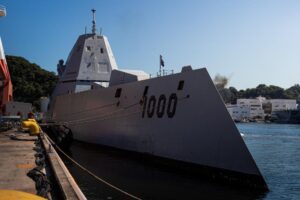The Navy issued a sources sought announcement on Nov. 17, conducting market research on opportunities to improve the interoperability and supportability of the Zumwalt-class destroyers by replacing unique components with analogous common Navy surface combatant components.
The concept is called the Zumwalt Enterprise Upgrade Solution (ZEUS).
The Navy said ZEUS would include several specific changes including replacing the ships’ Raytheon Technologies [RT] AN/SPY-3 radar with the AN/SPY-6(v)3 Enterprise Air Surveillance Radar designed for Ford-class aircraft carriers and the upcoming Constellation-class frigates.

Other elements the Navy is considering for the ZEUS upgrade include the combat system computer program, common displays, Cooperative Engagement Capability that communicate data between ship radars and fire control systems, the Surface Electronic Warfare Improvement Program (SEWIP), the Identify Friend-or-Foe (IFF) system, the AN/SQQ-89 surface ship anti-submarine warfare combat system and internal electronics of the Mark 41 Vertical Launching System (VLS).
The notice said the government is specifically seeking industry input on sources with the capabilities and facilities to conduct systems engineering, including model-based, to support combat system design, development and testing for the DDG-1000 platform.
The engineering development efforts include requirements analysis; system architecture; subsystem; component and test requirements development; design analysis and integration; cybersecurity engineering; modeling and simulation; and system integration, verification and validation testing to support combat system certification.
The Navy also wants input to determine if sources can perform software development; technical leadership; facilities and manpower to manufacture, integrate, install and support combat system equipment on the ship class; and facilities and manpower to support land-based integration and testing.
However, the notice clarified several ship issues that would not change with the ZEUS concept, notably that topside design impacts “should be minimized,” radar cross section requirements will stay the same, no change to the primary mission of the DDG-1000 class for surface strike, the minimal manning concept remains, and minimize impacts to manning.
The Navy also underscored that ZEUS would not include modernizing the Zumwalt-class’ Total Ship Computing Environment infrastructure (TSCEi) because it will occur before this upgrade.
The TSCEi includes core data processing and ship-wide network infrastructure. This pre-ZEUS upgrade will support infrastructure as a service (IaaS).
“Additionally ship control, integrated communications, and other select functions not associated with the combat system will remain in TSCE,” the Navy said.
This notice does not request industry provide an estimated cost or price for this work yet, but merely determine if sources are capable of satisfying this upgrade option.
Responses are due by Dec. 16.
This market research comes after the USS Zumwalt (DDG-1000) completed its first long-range employment to the Western Pacific (Defense Daily, Nov. 17).
The Navy already plans to send DDG-1000 into an 18-month maintenance availability over fiscal years 2024 and 2025 to replace the unused gun system with new missile tubes to host the Conventional Prompt Strike (CPS) hypersonic missile weapons. DDG-1000 is set to be the first naval vessel to host the CPS after the Army deploys a version of the weapon in 2023.
The three-ship Zumwalt-class ships were built by General Dynamics’ Bath Iron Works [GD] in Maine.